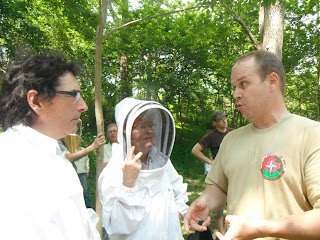
The last three weeks have been a blur of activity.
After a couple days deployment volunteering for Red Cross, driving a 26' U-Haul across the province from city to city, I sat in the a hotel room.
I realized I couldn’t remember what city I was in. We had hit the ground running that morning and had been to many cities, loading shelter cots to take to northern Canada where wildfires blazed. It was hot and sweaty work.
[Photo - a secondary swarm on a cedar hedge].
And after relaxing and washing off the sweat I couldn't remember where I was.
Back home bee swarms were happening like wildfires too. Every day the phone would ring and I’d be running. A swarm hanging on a branch, the person would report. It’s only six feet off the ground.

Who could resist free bees like that? It’s like picking apples.
I learned from a fellow beekeeper to ask the caller if the swarm was tennis, baseball, football or basketball sized. This would help a lot over the phone for me to determine if this is a first swarm (large) or a smaller secondary or tertiary swarm.
[Photo - two new hives set up].
The second or third swarms would have virgin queens. The best producing swarm is that first one with the mature mated queen.
I think it was the first three swarms that I lost out on that fed this new swarm collecting addiction. I just couldn’t let them go. I caught one off a cedar hedge, a secondary swarm 6’ off the ground. Easy as pie.

I got another in a man’s backyard. Football sized and after being clustered for 3 or 4 days it only took two small shakes of the tree branch to fill the nuc box. I left the box until dark and came back to pick them up and take them away. So easy.
Then back at the bee yard I was hitting the ground running every free minute I had doing inspections and splits, painting equipment and setting up new platforms.
I decided to change the orientation of the new hives from east to south facing.
After a couple weeks on the run after swarms I had a moment to relax in the bee yard.
I found myself looking at all these new hives. There were so many I couldn't remember which hive came from where.
I had six. But now I have 14.



















